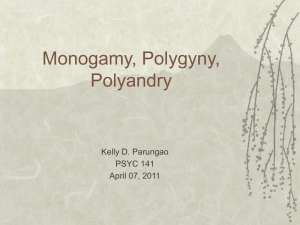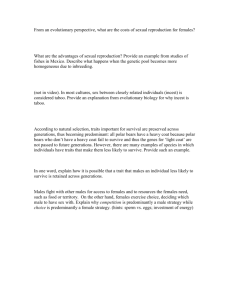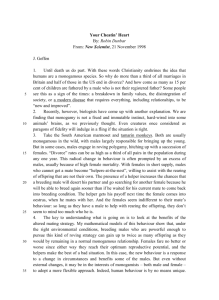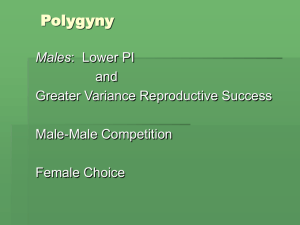The Evolution of Social Monogamy in Mammals
advertisement
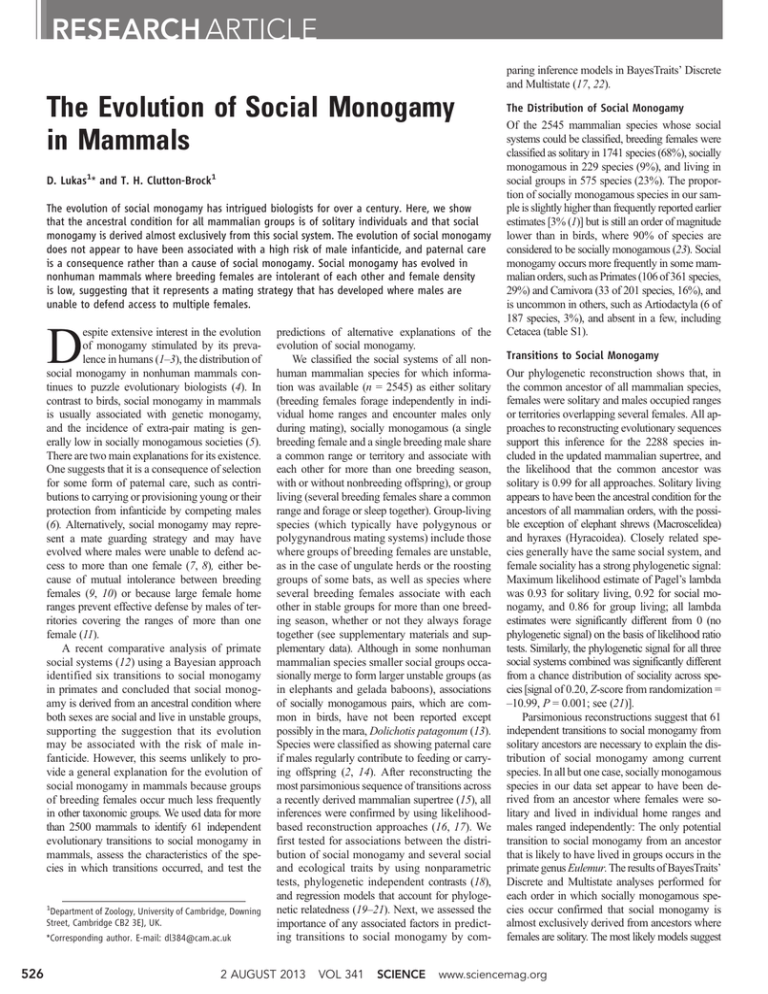
RESEARCH ARTICLE paring inference models in BayesTraits’ Discrete and Multistate (17, 22). The Evolution of Social Monogamy in Mammals D. Lukas1* and T. H. Clutton-Brock1 The evolution of social monogamy has intrigued biologists for over a century. Here, we show that the ancestral condition for all mammalian groups is of solitary individuals and that social monogamy is derived almost exclusively from this social system. The evolution of social monogamy does not appear to have been associated with a high risk of male infanticide, and paternal care is a consequence rather than a cause of social monogamy. Social monogamy has evolved in nonhuman mammals where breeding females are intolerant of each other and female density is low, suggesting that it represents a mating strategy that has developed where males are unable to defend access to multiple females. espite extensive interest in the evolution of monogamy stimulated by its prevalence in humans (1–3), the distribution of social monogamy in nonhuman mammals continues to puzzle evolutionary biologists (4). In contrast to birds, social monogamy in mammals is usually associated with genetic monogamy, and the incidence of extra-pair mating is generally low in socially monogamous societies (5). There are two main explanations for its existence. One suggests that it is a consequence of selection for some form of paternal care, such as contributions to carrying or provisioning young or their protection from infanticide by competing males (6). Alternatively, social monogamy may represent a mate guarding strategy and may have evolved where males were unable to defend access to more than one female (7, 8), either because of mutual intolerance between breeding females (9, 10) or because large female home ranges prevent effective defense by males of territories covering the ranges of more than one female (11). A recent comparative analysis of primate social systems (12) using a Bayesian approach identified six transitions to social monogamy in primates and concluded that social monogamy is derived from an ancestral condition where both sexes are social and live in unstable groups, supporting the suggestion that its evolution may be associated with the risk of male infanticide. However, this seems unlikely to provide a general explanation for the evolution of social monogamy in mammals because groups of breeding females occur much less frequently in other taxonomic groups. We used data for more than 2500 mammals to identify 61 independent evolutionary transitions to social monogamy in mammals, assess the characteristics of the species in which transitions occurred, and test the D 1 Department of Zoology, University of Cambridge, Downing Street, Cambridge CB2 3EJ, UK. *Corresponding author. E-mail: dl384@cam.ac.uk 526 predictions of alternative explanations of the evolution of social monogamy. We classified the social systems of all nonhuman mammalian species for which information was available (n = 2545) as either solitary (breeding females forage independently in individual home ranges and encounter males only during mating), socially monogamous (a single breeding female and a single breeding male share a common range or territory and associate with each other for more than one breeding season, with or without nonbreeding offspring), or group living (several breeding females share a common range and forage or sleep together). Group-living species (which typically have polygynous or polygynandrous mating systems) include those where groups of breeding females are unstable, as in the case of ungulate herds or the roosting groups of some bats, as well as species where several breeding females associate with each other in stable groups for more than one breeding season, whether or not they always forage together (see supplementary materials and supplementary data). Although in some nonhuman mammalian species smaller social groups occasionally merge to form larger unstable groups (as in elephants and gelada baboons), associations of socially monogamous pairs, which are common in birds, have not been reported except possibly in the mara, Dolichotis patagonum (13). Species were classified as showing paternal care if males regularly contribute to feeding or carrying offspring (2, 14). After reconstructing the most parsimonious sequence of transitions across a recently derived mammalian supertree (15), all inferences were confirmed by using likelihoodbased reconstruction approaches (16, 17). We first tested for associations between the distribution of social monogamy and several social and ecological traits by using nonparametric tests, phylogenetic independent contrasts (18), and regression models that account for phylogenetic relatedness (19–21). Next, we assessed the importance of any associated factors in predicting transitions to social monogamy by com- 2 AUGUST 2013 VOL 341 SCIENCE The Distribution of Social Monogamy Of the 2545 mammalian species whose social systems could be classified, breeding females were classified as solitary in 1741 species (68%), socially monogamous in 229 species (9%), and living in social groups in 575 species (23%). The proportion of socially monogamous species in our sample is slightly higher than frequently reported earlier estimates [3% (1)] but is still an order of magnitude lower than in birds, where 90% of species are considered to be socially monogamous (23). Social monogamy occurs more frequently in some mammalian orders, such as Primates (106 of 361 species, 29%) and Carnivora (33 of 201 species, 16%), and is uncommon in others, such as Artiodactyla (6 of 187 species, 3%), and absent in a few, including Cetacea (table S1). Transitions to Social Monogamy Our phylogenetic reconstruction shows that, in the common ancestor of all mammalian species, females were solitary and males occupied ranges or territories overlapping several females. All approaches to reconstructing evolutionary sequences support this inference for the 2288 species included in the updated mammalian supertree, and the likelihood that the common ancestor was solitary is 0.99 for all approaches. Solitary living appears to have been the ancestral condition for the ancestors of all mammalian orders, with the possible exception of elephant shrews (Macroscelidea) and hyraxes (Hyracoidea). Closely related species generally have the same social system, and female sociality has a strong phylogenetic signal: Maximum likelihood estimate of Pagel’s lambda was 0.93 for solitary living, 0.92 for social monogamy, and 0.86 for group living; all lambda estimates were significantly different from 0 (no phylogenetic signal) on the basis of likelihood ratio tests. Similarly, the phylogenetic signal for all three social systems combined was significantly different from a chance distribution of sociality across species [signal of 0.20, Z-score from randomization = –10.99, P = 0.001; see (21)]. Parsimonious reconstructions suggest that 61 independent transitions to social monogamy from solitary ancestors are necessary to explain the distribution of social monogamy among current species. In all but one case, socially monogamous species in our data set appear to have been derived from an ancestor where females were solitary and lived in individual home ranges and males ranged independently: The only potential transition to social monogamy from an ancestor that is likely to have lived in groups occurs in the primate genus Eulemur. The results of BayesTraits’ Discrete and Multistate analyses performed for each order in which socially monogamous species occur confirmed that social monogamy is almost exclusively derived from ancestors where females are solitary. The most likely models suggest www.sciencemag.org RESEARCH ARTICLE that no transitions to social monogamy from group living occurred except in the one instance in the primates. Models in which transition rates to social monogamy were forced to occur equally from group-living ancestors and solitary ancestors performed significantly worse than models in which all socially monogamous species are derived from a solitary ancestor [likelihood ratio test (lrt) all P < 0.005; table S2]. Group-living sister taxa of socially monogamous species occur in some groups (e.g., banded mongooses, Mungos mungo; Goeldii’s monkey, Callimico goeldii; sifakas, Propithecus spp.) and probably represent secondary transitions to group living from socially monogamous ancestors. Social Monogamy and Male Care Although it is often difficult to exclude the possibility of any form of male contribution to the care of young, detailed field studies have found no evidence of any form of male contribution to care in 94 of 229 (41%) socially monogamous species. For example, in dik-dik, where males are both genetically and socially monogamous and are closely associated with their mates, they provide no contributions to guarding, carrying, feeding, or teaching young or to any other obvious form of paternal care (24). The distribution of paternal care in contemporary socially monogamous species is closely associated with the form and distribution of maternal care: Where females carry and/or pro- vision offspring, males commonly contribute to the same activities. Regular provisioning or carrying of young by males has been recorded in 135 (59%) of the 229 socially monogamous mammals, whereas it is found only in three nonmonogamous species, two of which appear to be derived from a socially monogamous ancestor [M. mungo (25) and C. goeldii (26); the third species is Hapalemur griseus (27)]. Comparisons suggest that paternal care probably contributes to the fitness of both sexes: Females in socially monogamous species with biparental care produce more litters per year (median = 2, range from 0.9 to 9, n = 48 species) than in socially monogamous species without biparental care [median = 1, range from 0.2 to 7, n = 37 species; analysis of variance (ANOVA) F = 4.43, P = 0.04, phylogenetic generalized least squares (phy): lambda = 0.92, t = –2.6, P = 0.01] or in solitary species (median = 1.1, range from 0.2 to 7, n = 242 species; F = 7.56, P = 0.006, phy: lambda = 0.97, t = 2.1, P = 0.03). Increases in the reproductive rate of females probably have benefits to males, who sire offspring in more breeding cycles in socially monogamous species with paternal care (median = 6 breeding seasons, range from 4.5 to 8 breeding seasons, n = 11 species) than in socially monogamous species where males do not provide care (median = 3 breeding seasons, range from 2 to 8 breeding seasons, n = 8 species; F = 4.98, P = 0.04; phy: lambda = 0.78, t = 2.0, 1.0 Estimated probability of social monogamy 0.8 0.6 0.4 0.2 P = 0.06), even though there are no differences in male tenure length (with paternal care median = 47 months, without median = 45 months; F = 2.10, P = 0.17, phy: lambda = 0.53, t = –1.1, P = 0.31). Although paternal care and social monogamy are associated, an analysis of transitions suggests that male care is probably a consequence rather than a cause of the evolution of social monogamy. About half of all independent transitions to paternal care have occurred in instances where social monogamy was already established, whereas the evolution of paternal care occurred on the same branch as a transition to social monogamy in the other cases. Inferences from BayesTraits’ models indicate that paternal care is a secondary adaptation, because transitions to social monogamy are inferred to occur first on branches where both traits evolved separately (lrt P = 0.002; table S2). Social Monogamy and Male Infanticide An alternative suggestion is that social monogamy allows males to protect their offspring from attacks by infanticidal competitors and has evolved for this reason (28). However, the available evidence suggests that male infanticide is unlikely to be the principal mechanism for the evolution of social monogamy in mammals. Male infanticide is typically found in species where the duration of lactation exceeds the duration of gestation (6, 28): This is the case in few socially monogamous species (20 of 75 species, 27%) compared with species where females are solitary [148 of 335 species, 44%; Wilcoxon W = 11733, P = 0.34; phylogenetic independent contrasts ( pic) t = –1.63, P = 0.10], and BayesTraits’ models also provide no evidence of an association between the evolution of social monogamy and lactation durations that exceed gestation (lrt P > 0.40, table S2). Although the prevalence of male infanticide is lower among socially monogamous species (4 of 47 species, 9%) than among solitary species (24 of 88 species, 27%; W = 1542.5, P = 0.01), this difference does not appear to be a consequence of a direct association between social monogamy and male infanticide, because an analysis of phylogenetic independent contrasts (t = –0.402, P = 0.69) and BayesTraits’ models suggest an independent evolution of the two traits (lrt P > 0.90, table S2). 0.0 -2 -1 0 1 2 Population density 3 4 5 (log individuals per km2) Fig. 1. Fitted values of the probability that a species is socially monogamous given a population density obtained by a binomial GLM (dashed line). The blue dots are the observed values for solitary species (n = 411), the red crosses the observed values for socially monogamous species (n = 89, 18% of all species), and values can overlap (e.g., there are four socially monogamous species with a log population density of –2). Population density (logarithm of the number of individuals per km2) has a substantial influence on the probability of that a species is socially monogamous or solitary. At the highest population densities, there is only a 6% probability that a species will be socially monogamous, whereas the probability rises to 44% at the lowest population densities. Several of the socially monogamous species showing high population densities are cooperative breeders, where many of the adult individuals do not breed. www.sciencemag.org SCIENCE VOL 341 Social Monogamy and the Ecological Defensibility of Females The main alternative explanation of the distribution of social monogamy in mammals is that it has evolved where females are solitary and males are unable to defend access to more than one female at a time (7). Evidence that socially monogamous species are derived from ancestors where females are solitary (see above) supports this suggestion. Moreover, unlike previous analyses (2, 4), our data show that socially monogamous mammals live at significantly lower densities (median of 15 individuals per square kilometer, n = 89 species) than solitary species [median of 156 2 AUGUST 2013 527 RESEARCH ARTICLE individuals per square kilometer, n = 411 species; W = 10746.5, P < 0.001; phylogenetically controlled binomal generalized linear model (GLM) in MCMCglmm (pMCMC) P = 0.007] (Fig. 1). Socially monogamous species have, on average, higher individual body mass (median = 873 g) compared with solitary species (median = 308 g; W = 40733, P = 0.001; pMCMC = 0.34), which may contribute to their low density. However, the residuals of a phylogenetically controlled regression of population density on body mass are significantly lower for socially monogamous species than for solitary species (W = 10421, P < 0.001; pMCMC < 0.001), indicating that size differences alone do not account for the low density of socially monogamous species. Despite the association between social monogamy and low population density, there is no significant difference in female home-range size between socially monogamous (median = 0.21 square kilometers, n = 71 species) and solitary (median = 0.53 square kilometers, n = 185 species; W = 5553, P = 0.06; pMCMC = 0.11) species, even when differences in body mass are controlled for (W = 6100, P = 0.70; pMCMC = 0.08). This suggests that there may be greater Fig. 2. Evolutionary pathway to monogamy and singular cooperative breeding in mammals. In mammals, social monogamy derives from ancestral social systems in which females are solitary and male ranges overlap those of several females. Social monogamy appears to have evolved in species where females rely on high-quality, low-density diets; breeding females are intolerant of each other; and female density is low, preventing breeding males from guarding more than one breeding female. In some monogamous lineages where females 528 2 AUGUST 2013 VOL 341 overlap of home ranges between females in solitary species than in socially monogamous ones, and comparative data for primates (the only taxonomic group for which comparative data are available) support this conclusion: In a sample of 26 socially monogamous primates, home ranges overlap on average by 21% (median = 17%), whereas the ranges of females overlap on average by 49% (median = 58%, n = 5 species; F = 7.08, P = 0.01; phy: lambda = 0.0, t = –2.4, P = 0.02) in species where females are solitary. The high incidence of social monogamy in Primates and Carnivora compared with more herbiv- are polytocous and habitats are unpredictable, systems where one female monopolizes breeding and her young are raised by other group members who are typically close relatives that have not yet left their natal group have evolved (29). [Photo credits: red squirrel (33), numbat (34), cheetah (35), armadillo (36), dik-diks (37), night monkeys (38), small-clawed otters (39), elephant shrew (40), naked mole rats (41), wolves (42), golden lion tamarins (43), beavers (44). All photos made available under Creative Commons attribution licenses.] SCIENCE www.sciencemag.org RESEARCH ARTICLE orous orders (including Rodentia and Artiodactyla) suggests that the evolution of low range-overlap in females and social monogamy may be a consequence of a reliance on resources of high nutritional quality but low abundance. Comparisons show that a similar association between social monogamy and low-density resources occurs within orders. For example, in 91% (81 of 89) of socially monogamous primates, fruit constitute the main part of the diet, whereas fruit is the single most important food for only 28% (13 of 46) of solitary primate species (W = 762.5, P < 0.001; pic t = 3.12, P = 0.002). In contrast, foods of low nutritional value (gum, bark, fungi) are included in the diet of significantly more solitary (43 of 46, 93%) than socially monogamous primate species (35 of 89, 39%; W = 3155.5, P < 0.001; pic t = – 4.18, P < 0.001). Analyses of patterns of sexual dimorphism also suggest that competition between females may be more intense in socially monogamous species than in solitary. Although males are heavier than females in 134 of 170 species (79%) where females are solitary, male-biased sexual dimorphism is found in only 21 of 44 socially monogamous species (48%; W = 2736.5, P < 0.001; pic t = 1.53, P = 0.13). This difference does not appear to be a consequence of a reduction in dimorphism after the transition to social monogamy, for the sequence of transitions (as inferred by the most likely BayesTraits’ models) suggests that social monogamy only evolved in species in which females are at least as large as males (lrt P < 0.05; table S2) and that in some socially monogamous species changes in evolutionary conditions appear to have led to subsequent increases in sexual dimorphism, preceding the loss of social monogamy. Discussion Like previous analyses (2, 12), our results suggest that the evolution of social monogamy has been restricted to particular ancestral states. However, our conclusion that social monogamy is derived from an ancestral state in which females are solitary and male ranges overlap those of several females contrasts with recent suggestions that, in primates, it is derived from ancestors in which females and males live in unstable groups (12). This difference is unlikely to be a consequence of contrasts between primates and other mammals, for five of the six transitions to social monogamy among primates in our data set were also from ancestors where females were solitary. Instead, it is likely to be a consequence of a contrast in the classification of social systems: Shultz et al. classify socially monogamous species that are accompanied by nonbreeding offspring as group living and do not distinguish between social systems of this kind and plural breeders, where groups include several breeding females. As a result, some species that we classify as socially monogamous were classified by Shultz et al. as group living. This difference in classification highlights the extent to which the way in which social systems are classified can influence the interpretation of species differences. The association between social monogamy and low population density also differs from previous analyses, which found no significant difference in population density between socially monogamous species and those where females live in separate home ranges (2, 4). In this case, it seems likely that the contrast is a result of differences in sample size between our analyses and previous analyses, where sample size was less than 90 species (2, 4). Our larger sample size also allowed us to assess whether changes in population density preceded transitions to social monogamy, whereas comparing average population density between solitary and socially monogamous species may fail to detect a difference because changes to low population density in social species might not necessarily lead to the evolution of social monogamy (14). Our results suggest that social monogamy evolved in mammals where feeding competition between females was intense, breeding females were intolerant of each other, and population density was low (Fig. 2). Under these conditions, guarding individual females may represent the most efficient breeding strategy for males (7). The evolution of paternal care appears to have succeeded the evolution of social monogamy, suggesting that it is unlikely to be a precondition for its evolution. Transitions to singular cooperative breeding occurred in a small number of socially monogamous species (29), and occasionally plural breeding by several females whose offspring are raised by all group members evolved from such an ancestor [e.g., banded mongooses (25)]. This suggests that there are at least two independent routes to female sociality in mammals. Because all the African apes are polygynous and group living, it is likely that the common ancestor of hominids was also polygynous, and this is supported by evidence of substantial sexual size dimorphism in early hominids (30), as well as by sex differences in rates of aging in modern humans (31). It has been suggested that the evolution of human monogamy could have been a consequence of the need for extended paternal investment (3). Alternatively, the rarity of transitions to social monogamy from groupliving, polygynous species in nonhuman mammals could suggest that the shift to monogamy in humans may be instead the result of a change in dietary patterns that reduced female density and limited the potential for males to guard more than one female (32). References and Notes 1. D. G. Kleiman, Q. Rev. Biol. 52, 39–69 (1977). 2. P. N. M. Brotherton, P. E. Komers, in Monogamy: Mating Strategies and Partnerships in Birds, Humans, and Other Mammals, C. Boesch, U. Reichard, Eds. (Cambridge Univ. Press, Cambridge, 2003), pp. 42–58. 3. S. Gavrilets, Proc. Natl. Acad. Sci. U.S.A. 109, 9923–9928 (2012). www.sciencemag.org SCIENCE VOL 341 4. F. S. Dobson, B. M. Way, C. Baudoin, Behav. Ecol. 21, 747–752 (2010). 5. T. H. Clutton-Brock, K. Isvaran, Biol. Lett. 2, 513–516 (2006). 6. C. P. van Schaik, in Primate Males: Causes and Consequences of Variation in Group Composition, P. Kappeler, Ed. (Cambridge Univ. Press, Cambridge, 2000), pp. 61–71. 7. S. T. Emlen, L. W. Oring, Science 197, 215–223 (1977). 8. S. M. Shuster, M. J. Wade, Mating Systems and Mating Strategies (Princeton Univ. Press, Princeton, NJ, 2003). 9. J. F. Wittenberger, R. L. Tilson, Annu. Rev. Ecol. Syst. 11, 197–232 (1980). 10. U. Reichard, in Monogamy: Mating Strategies and Partnerships in Birds, Humans, and Other Mammals, C. Boesch, U. Reichard, Eds. (Cambridge Univ. Press, Cambridge, 2003), pp. 190–213. 11. G. H. Orians, Am. Nat. 103, 589–603 (1969). 12. S. Shultz, C. Opie, Q. D. Atkinson, Nature 479, 219–222 (2011). 13. A. B. Taber, D. W. Macdonald, J. Zool. 227, 417–438 (1992). 14. C. P. Van Schaik, P. Kappeler, in Monogamy: Mating Strategies and Partnerships in Birds, Humans, and Other Mammals, C. Boesch, U. Reichard, Eds. (Cambridge Univ. Press, Cambridge, 2003), pp. 59–80. 15. S. A. Fritz, O. R. P. Bininda-Emonds, A. Purvis, Ecol. Lett. 12, 538–549 (2009). 16. D. Schluter, T. Price, A. O. Mooers, D. Ludwig, Evolution 51, 1699–1711 (1997). 17. M. Pagel, Nature 401, 877–884 (1999). 18. J. Felsenstein, Am. Nat. 125, 1–15 (1985). 19. R. P. Freckleton, P. H. Harvey, M. Pagel, American Naturalist 160, 712–726 (2002). 20. J. D. Hadfield, S. Nakagawa, J. Evol. Biol. 23, 494–508 (2010). 21. More detailed information on materials and methods is available on Science Online. 22. M. Pagel, A. Meade, Am. Nat. 167, 808–825 (2006). 23. A. Cockburn, Proc. Biol. Sci. 273, 1375–1383 (2006). 24. P. N. M. Brotherton, M. B. Manser, Anim. Behav. 54, 1413–1424 (1997). 25. M. Cant, J. Zool. 259, 115–121 (2003). 26. L. M. Porter, Folia Primatol. 72, 69–79 (2001). 27. P. C. Wright, Int. J. Primatol. 11, 89–102 (1990). 28. C. P. Van Schaik, R. I. M. Dunbar, Behaviour 115, 30–62 (1990). 29. D. Lukas, T. Clutton-Brock, Proc. R. Soc. London Ser. B 279, 2151–2156 (2012). 30. J. M. Plavcan, Hum. Nat. 23, 45–67 (2012). 31. L. Mealy, Sex Differences: Developmental and Evolutionary Strategies (Academic Press, San Diego, CA, 2000). 32. K. E. Langergraber, J. C. Mitani, D. P. Watts, L. Vigilant, Behav. Ecol. Sociobiol. 67, 861–873 (2013). 33. Ray eye, http://en.wikipedia.org/wiki/File:Eichhörnchen_ Düsseldorf_Hofgarten.jpg. 34. A. Carter, http://en.wikipedia.org/wiki/File:Ninebanded_Armadillo.jpg. 35. Mukul2u, http://commons.wikimedia.org/wiki/File: Cheetah_Kruger.jpg. 36. Tomfriedel, http://en.wikipedia.org/wiki/File:Ninebanded_Armadillo.jpg. 37. P. Brotherton, https://commons.wikimedia.org/wiki/File: Dik-dik_%28male%29_-Tarangire_National_Park_Tanzania.jpg. 38. Tomfriedel, https://commons.wikimedia.org/wiki/File: Panamanian_Night_Monkeys2.jpg. 39. Andjam, https://commons.wikimedia.org/wiki/File: Aonyx_cinera_in_Zoo-002.jpg. 40. J. Makalintal, https://commons.wikimedia.org/wiki/File: Rhynchocyon_petersi_from_side.jpg. 41. R. Owen, www.flickr.com/photos/bobowen/4252523174/. 42. J. Weber, www.flickr.com/photos/jeremyweber/ 7744688998. 43. Art G., www.flickr.com/photos/digitalart/2267158454. 44. Finchlake2000, www.flickr.com/photos/finchlake/ 5460526644/in/photostream/. 2 AUGUST 2013 529 Acknowledgments: We thank D. Blumstein, S. Dobson, P. Kappeler, and N. Solomon for detailed comments and critical feedback on the classification of species and B. Dantzer, E. Huchard, C. Logan, and everyone in the Large Animal Research Group in Cambridge for helpful discussions. Data are available as supplementary materials. The Leverhulme Trust, the Isaac Newton Trust, and the European Research Council provided the funding for this study. Tables S1 to S3 References (45–70) Data Set S1 Supplementary Materials www.sciencemag.org/cgi/content/full/341/6145/526/DC1 Materials and Methods Fig. S1 3 April 2013; accepted 14 June 2013 10.1126/science.1238677 REPORTS Hierarchical Porous Polymer Scaffolds from Block Copolymers Hiroaki Sai,1 Kwan Wee Tan,1 Kahyun Hur,1* Emily Asenath-Smith,1 Robert Hovden,2,3 Yi Jiang,4 Mark Riccio,5 David A. Muller,2,3 Veit Elser,4 Lara A. Estroff,1 Sol M. Gruner,3,4,6 Ulrich Wiesner1† Hierarchical porous polymer materials are of increasing importance because of their potential application in catalysis, separation technology, or bioengineering. Examples for their synthesis exist, but there is a need for a facile yet versatile conceptual approach to such hierarchical scaffolds and quantitative characterization of their nonperiodic pore systems. Here, we introduce a synthesis method combining well-established concepts of macroscale spinodal decomposition and nanoscale block copolymer self-assembly with porosity formation on both length scales via rinsing with protic solvents. We used scanning electron microscopy, small-angle x-ray scattering, transmission electron tomography, and nanoscale x-ray computed tomography for quantitative pore-structure characterization. The method was demonstrated for AB- and ABC-type block copolymers, and resulting materials were used as scaffolds for calcite crystal growth. ierarchically porous scaffolds provide synergies between mechanical properties, transport properties, and enhanced surface area (1). Integrating mesoscale (2 to 50 nm) porosity with three-dimensional (3D) continuous macropores (>50 nm) is of particular importance because it combines high specific surface area with high flux and pore accessibility desired, for example, in catalytic conversions. Potential applications range from catalysis to separation technology to bioengineering. Among polymeric materials, block copolymer (BCP) self-assembly is known to offer access to mesoscale-ordered structures with tunable size and morphology through control over molecular parameters such as block chemistry, sequence, and molar mass (2). Specific methods have been developed to form mesopores, including chemical block removal (3–5) and swelling with sacrificial components (6–9). The strong interest in hierarchical polymer scaffolds has resulted in specific strategies for structure generation at multiple length H 1 Department of Materials Science and Engineering, Cornell University, Ithaca, NY 14853, USA. 2School of Applied and Engineering Physics, Cornell University, Ithaca, NY 14853, USA. 3Kavli Institute at Cornell for Nanoscale Science, Ithaca, NY 14853, USA. 4Department of Physics, Cornell University, Ithaca, NY 14853, USA. 5Cornell University Institute of Biotechnology, Cornell University, Ithaca, NY 14853, USA. 6Cornell High Energy Synchrotron Source (CHESS), Cornell University, Ithaca, NY 14853, USA. *Present address: Center for Computational Science, Korea Institute of Science and Technology, Seoul 136-791, Republic of Korea. †Corresponding author. E-mail: ubw1@cornell.edu 530 scales using BCPs, such as confined self-assembly in preformed macroscale templates (10–12) and nonsolvent- or polymerization-induced phase sep- aration (13–16). However, when combined together these approaches often require specific chemistries, only work in narrow synthesis parameter windows, or rely on multiple tedious steps that limit their general use (8). Moreover, quantitative structural assessments of nonperiodic porosity remains challenging. A well-studied physical phenomenon in polymer science is the spinodal decomposition of polymer blends (17, 18). By driving a multicomponent polymeric mixture to a supersaturated state through control of temperature or through quick solvent evaporation, a continuous interface at the micrometer scale emerges upon phase segregation. A facile and versatile, yet unexplored approach for generating hierarchical porosity would be to induce spinodal decomposition in a BCPadditive blend that would separate into an additiverich phase and a BCP-rich phase, where one block gets selectively swollen by the additive (Fig. 1). Rinsing out both the additive-rich phase and the additive swelling of the BCP block with the same selective solvent enables hierarchical Fig. 1. Schematic for the synthesis method and ternary phase diagram. Synthesis of hierarchically porous polymer scaffolds with ordered mesostructure using the SIM2PLE method. Red color on the surface of the pores suggests PEO lining. Schematic ternary phase diagram shows paths to hexagonal and network mesostructures via solvent evaporation. 2 AUGUST 2013 VOL 341 SCIENCE www.sciencemag.org
